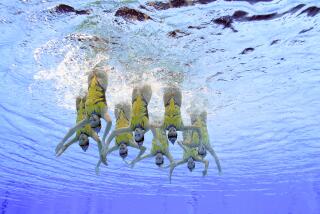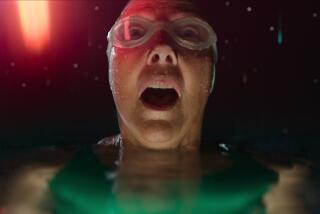Swimming troupe Aqualillies is making a splash in Hollywood with Coen brothers’ ‘Hail, Caesar!’
- Share via
When a team of bikini-clad Aqualillies filed into the humid, chlorinated confines of a Woodland Hills indoor pool, even the been-there, done-that stagehands couldn’t help but stare.
But when they got into the water, all prurient curiosity gave way to naked awe. The swimmers moved like some kind of superhuman race or mechanized Disneyland ride, snapping their arms with crisp precision as their legs churned away like eggbeaters out of sight. In one instant, they torpedoed their bodies into the air, only to disappear into the depths the next.
Don’t let the name fool you. These are serious athletes disguised as midcentury bombshells.
See more of Entertainment’s top stories on Facebook >>
“It’s something that comes naturally,” Aqualillies executive director and choreographer Mary Jeannette Ramsey said in a grand understatement the next day. “Because we’ve learned the physics of our bodies in the water.”
In case you missed it, the Aqualillies are having a Moment. Until recently, their synchronized swimming spectacles were largely VIP affairs, reserved for the Hollywood glitterati. (They got their big break as Justin Timberlake’s 30th birthday surprise.)
Lately, though, the Aqualillies have popped up in TV commercials and the music videos of Justin Bieber, Katy Perry and Ariana Grande. On Feb. 5, they make their big-screen debut in the Coen brothers’ new comedy “Hail, Caesar!” helping Scarlett Johansson look that much better in a mermaid tail. On Feb. 19, the results of that eye-popping Woodland Hills rehearsal will air as an Esther Williams-inspired sequence on the CW’s “Jane the Virgin.”
“There’s always been a desire for this,” said the Aqualillies’ Ramsey, the assistant swim choreographer on “Hail, Caesar!” and herself a former competitive synchronized swimmer. “It went dormant for a while. Aqualillies gave it a vehicle to come back.”
A too-deep pool
In the 1940s, water-ballet numbers were so popular that MGM built its star Williams a 29-foot deep swimming pool, 90 feet wide and 90 feet long for her 1944 film “Bathing Beauty.” It featured an underwater “bucket camera,” colored fountains, geysers and fireworks, and a hydraulic lift to raise Williams 50 feet out of the water. But the daring and extravagance also came with a cost.
The pool was so deep that Williams, a former Olympic hopeful who did all her own stunts, reportedly ruptured her eardrums repeatedly. After a high dive while wearing a metal crown in the studio’s hit “Million Dollar Mermaid,” a stunt replicated in “Hail, Caesar!,” Williams’ head hit the water at an awkward angle and she broke her back. She once got trapped in an underwater mechanical clam shell and almost drowned.
“They learned a lot about what works and what doesn’t,” said “Hail, Caesar!” executive producer Robert Graf. “We had to relearn a lot of these things as we went along. … This is the biggest thing in this vein anyone’s done in quite a while.”
There were no such catastrophes on the set of Universal Pictures’ “Hail, Caesar!” Indeed, the studio kept rescue boats and lifeguards on hand throughout the shoot. But there remained a steep learning curve.
For starters, they quickly realized the only pool that would properly accommodate the Coen brothers’ vision was the same 700,000-gallon one on Stage 30 that Williams made famous, on what is now the Sony Pictures lot.
Through trial and error and hours spent reviewing clips from Williams’ 1951 film “Million Dollar Mermaid,” “Neptune’s Daughter” and others, they discovered the color of the pool floor was crucial. It had to be black for some moments and light for others. Even more key, however, was water clarity. And that only came after installing what Graf called a “super, hardcore filtration system.”
The choreography of the film’s kaleidoscopic snowflake required months of experimentation in far-flung swimming pools around L.A.
“You don’t know till you see it,” said Graf. “We’d have to find a pool, round up 30 women, get a cheap video camera and tie it on the ceiling, looking down and feed it to a TV.”
The Aqualillies have a repertoire of routines, but naturally the Coens wanted something custom. Ultimately, the performance combined vintage formations with the more modern, more athletic techniques.
“Joel and Ethan take what they do so seriously and then they trust the creativity of the artist,” said Aqualillies founder and creative director Mesha Kussman, who served as swim choreographer on “Hail, Caesar!” “At the same time, they’re uncompromising about their vision. They’re so specific.”
------------
For the record, 12:10 p.m. Feb. 5: An earlier version of this post said that Mesha Kussman is the co-founder of the Aqualillies. She is the founder.
------------
Through trial and error, they determined that the swimmers’ suits had to be two-toned. And a custom-made iron ring was required for them to balance on, so their perfect circle didn’t drift out of the frame.
“The trickiest aspect was figuring out how to keep 32 girls in a perfect circle, right under the camera,” said Aqualillies executive director Ramsey. “It was almost a new category of synchronized swimming.”
‘Water acrobatics’
Synchronized swimming began as “water acrobatics” at the turn of the 20th century, popularized by Australian swimmer and vaudeville star Annette Kellerman. During the 1930s, the sport was put to music and then popularized in film by Williams.
“She really invented how to move gracefully on camera,” said Aqualillies’ Kussman. “There’s a whole world in the way she just moves her shoulder. She manages to swim but keep her face toward the camera and keep her eyes opened, looking at you, when she really can’t see a damn thing.”
Synchronized swimming became an Olympic sport in 1984, debuting in the 1988 Seoul Games and paving the way for the Aqualillies.
Kussman launched the group in 2008 with little more than a well-designed website and a handful of competitive swimmers looking for work. She’d only recently returned home to California after graduating from New York University as an installation artist and choreographer.
“I kept going to pool parties, and I kept thinking [the pool] looked like a stage,” she said. “Water itself is so beautiful and majestic. I just got it in my mind it wouldn’t let go that there should be dancers in the water.”
It turned out there were a lot of champion synchronized swimmers, many of whom were in their 20s when they retired. Today, Aqualillies includes several former Olympians and has troupes in Las Vegas, New York, Miami and since last October, Canada, Australia and Europe. In Southern California, they offer regular fitness classes at the Annenberg Community Beach House in Santa Monica.
Williams herself was an Aqualillies fan. She was in her late 80s when she discovered them but was so entranced that she insisted on watching all their rehearsals for one particular Hollywood Roosevelt performance. She made sure to sit front and center. After her death at 91 in 2013, the Aqualillies performed at her memorial.
“She turned out to be the most glamorous, intelligent, witty, philanthropic, brave woman of all time,” said Kussman. “She was incredible. She made it up as she went along too.”
ALSO
Watch the moments that might win them an Oscar
Multi-Ethnic Media Coalition to focus its efforts on the film industry
Congressmen send letter to film academy and call diversity plan a ‘first step’
More to Read
Only good movies
Get the Indie Focus newsletter, Mark Olsen's weekly guide to the world of cinema.
You may occasionally receive promotional content from the Los Angeles Times.









